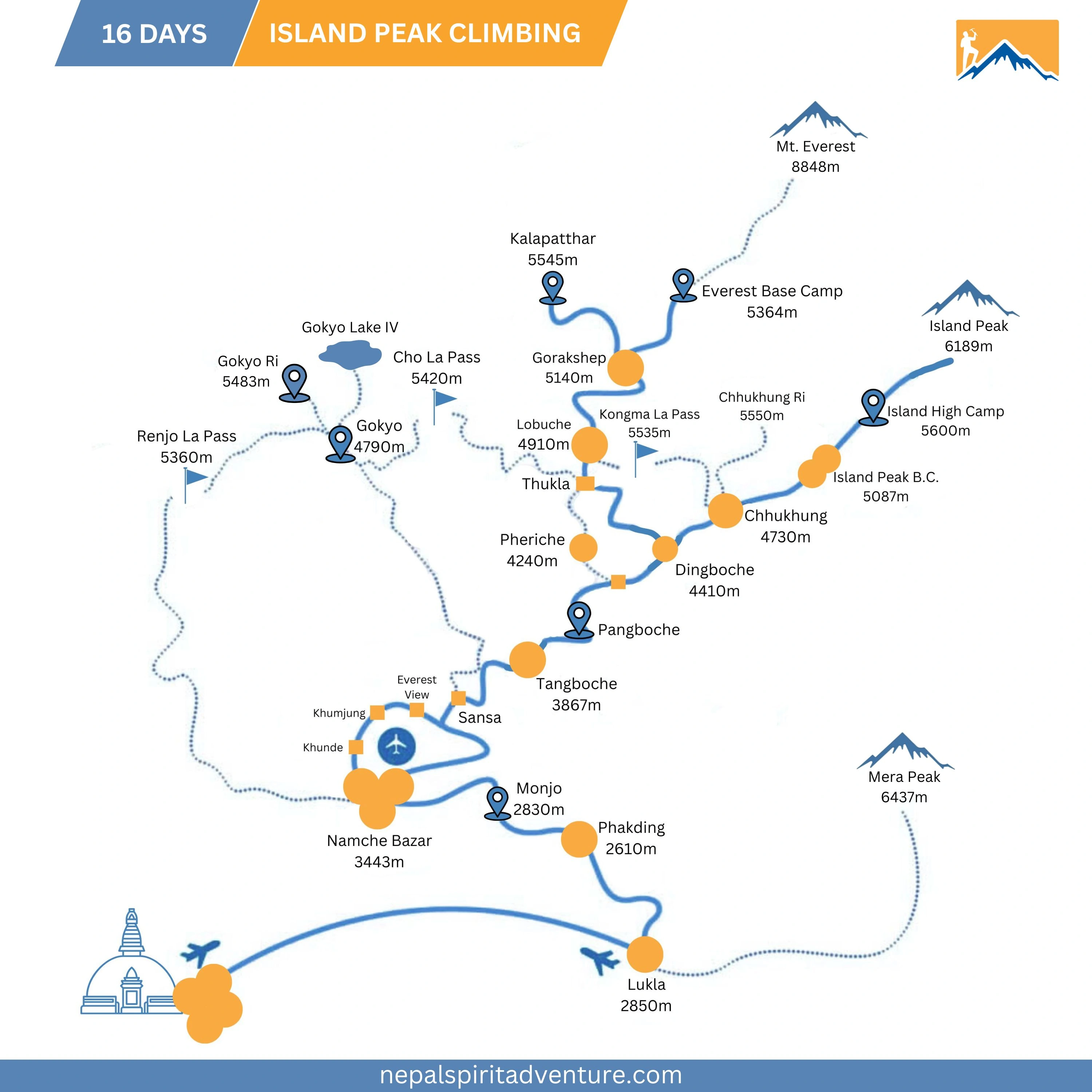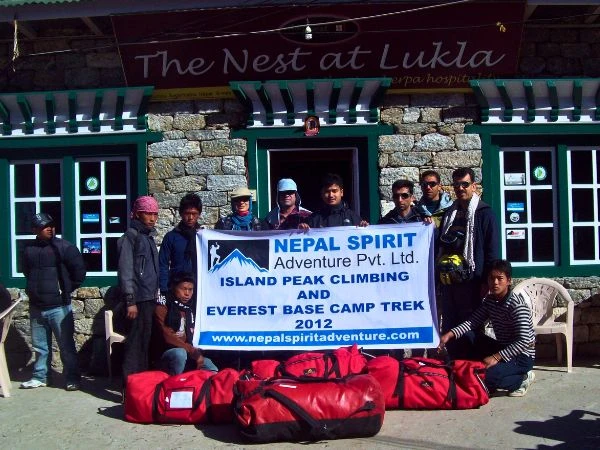Have you ever dreamed of standing on a Himalayan peak, looking out at a breathtaking expanse of towering giants like Everest (the Earth's highest point, soaring at an astonishing 8,8848.86m/ 29,301 ft) and Lhotse (the World's 4th highest peak, reaching up to 8,516m/ 27,940 ft), with a profound sense of achievement? That exhilarating moment could be just around the corner, and Island Peak/ Imja Tse at 6,189m is your gateway to this unforgettable experience. More than just a climb, it's a journey that will ignite your spirit and transform you from a trekker into a mountaineer. Picture yourself traversing the iconic trails of the Everest region, facing thrilling alpine challenges along the way. Get ready to embrace the thrill of a lifetime.
About Island Peak Climbing
Island Peak Climbing is an exhilarating and unforgettable adventure that promises a lifetime of memories. This remarkable journey takes travelers through the breathtaking Khumbu region of Everest, immersing them in the stunning landscapes of the Sagarmatha National Park. As you traverse this incredible terrain, you'll encounter vibrant ethnic villages, each with its unique culture and traditions, all set against the backdrop of towering Himalayan peaks. The ascent to Island Peak is a perfect blend of adventure and beauty, providing an ideal opportunity to test your trekking and climbing skills. Embrace the thrill and create unforgettable memories amidst some of the world's most stunning landscapes.
Why Island Peak Climbing?
The Island Peak climbing is more than a checklist item; it's a multi-layered adventure that engages every sense.
- A Rite of Passage for Aspiring Mountaineers; Island Peak is famously the training ground for legends. Sir Edmund Hillary and Tenzing Norgay used it to prepare for their historic Everest summit, and you, too, will walk in their footsteps. Climbing Island Peak offers individuals the perfect introduction to the technical skill of high-altitude mountaineering in a supported environment.
- Two Iconic Adventures in One: Your journey seamlessly blends the world-famous Everest Base Camp Trek with an exhilarating summit climb. You'll acclimatize on the trail, passing through vibrant Sherpa villages like Namche Bazaar and visiting ancient monasteries like Tengboche, all while building towards your ultimate goal.
- Views That Will Stay With You Forever: The 360-degree panorama from the summit is what dreams are made of. You will be surrounded by an awe-inspiring wall of Himalayan giants: the mighty Everest, the towering south face of Lhotse, the majestic Makalu, and the beautiful Ama Dablam. It's a view you earn with every single step.
When is the best time to climb Island Peak?
The best times to climb Island Peak are during the pre-monsoon spring season (March to May ) and the post-monsoon autumn season (mid-September to November).
The Spring Season welcomes you with lush, blooming rhododendron forests and panoramic views of the surrounding mountains. What enhances it is a blossoming desert flora, including wildflowers and fields of buckwheat, creating an enchanting spectacle.
During the autumn season, the trails are vibrant with lush post-monsoon vegetation. This makes it the perfect time for crystal-clear skies and vibrant festivals in the Khumbu region, especially the Mani Rimdu festival in Tengboche.
The monsoon and Winter Seasons are not considered the best times or off-season to travel because of dangerous weather & terrain, frequent delays in flights, and limited availability of tea houses with brutal cold and wind chill, respectively.
What does the climb physically feel like?
The summit push is an intense and unforgettable experience. You'll start around 1-2 AM from High Camp, climbing by headlamp through the cold, dark silence. The journey involves a scenic glacier crossing, navigating ladders over crevasses, and the final steep headwall- a 45- 60 degree ice slope climbed using a fixed rope and ascender (jumar). Reaching the summit as the sun rises over the Himalayas is an emotional and triumphant moment that makes all the effort worthwhile.
How hard is Island Peak to climb?
It's a serious climb, not just a trek. While suitable for fit beginners, it involves technical sections like a steep ice headwall requiring crampons, ice axes, and fixed ropes. Many underestimate it; proper training and a good operator are key to success.
What is the summit day on Island Peak like?
Summit day is long and demanding, starting around 1-2 AM. The climb involves rocky terrain, a glacier traverse, and a technical 150-300 meter ice wall before reaching the summit, taking 10-14 hours round-trip.
Is Island Peak for me?
Yes, if you are physically fit and have a strong adventurous spirit! While it's a challenging climb, it's considered one of the most accessible peaks in the Himalayas for those new to mountaineering. The key is excellent physical fitness, mental determination, and a willingness to learn basic technical skills.
Can I climb Island Peak with no experience?
Yes, you can, but it requires excellent physical fitness and a willingness to learn. A guided package with a pre-summit climbing clinic is essential to teach you the necessary rope work, crampon use, and safety procedures.
What does the climb physically feel like?
The summit push is an intense and unforgettable experience. You'll start around 1-2 AM from High Camp, climbing by headlamp through the cold, dark silence. The journey involves a scenic glacier crossing, navigating ladders over crevasses, and the final steep headwall- a 45- 60 degree ice slope climbed using a fixed rope and ascender (jumar). Reaching the summit as the sun rises over the Himalayas is an emotional and triumphant moment that makes all the effort worthwhile.
What kind of training do I need for Island Peak?
Focus on 3-6 months of training for endurance, strength, and stability. This should include uphill hiking with a weighted pack (building to 20-25 lbs), cardiovascular exercise, and strength work.
What is the success rate, and how can I maximize mine?
Success depends on fitness, an acclimatization plan, weather, and the quality of your guide services. You can dramatically increase your chances by;
- Choosing an operator with a proven acclimatization plan and experienced, dedicated climbing guides who are with you from the start.
- Undertaking serious physical training for 4-6 months prior, focusing on cardiovascular endurance and leg strength.
- Opting for an itinerary that uses High Camp, which shortens summit day and increases the probability of a successful ascent.
Do I need a Permit to climb Island Peak? If so, How Can I get the Permit? What is the cost for Permits?
Yes, you absolutely need a permit to climb Island Peak. You require 3 different permits, and here is everything in quick;
| Permit Type |
Issuing Authority |
Cost (USD) |
Key Details |
| Climbing Permit |
Nepal Mountaineering Association (NMA) |
$350 (Spring; Mar-May)
$175( Autumn, Winter, Summer)
|
Cost varies by season; mandatory for summit climb. |
| Sagarmatha National Park Permit |
Department of National Parks and Wildlife Conservation
|
~$30 (NPR 3,000) |
Required to enter the Everest region national park. |
| Khumbu Pasang Lhamu Rural Municipality Permit |
Local Municipality Office |
~$30 (NPR 3,000) |
Local Area entry permit; obtainable in Lukla |
It's important to note that individuals cannot obtain the Island Peak climbing permit on their own. You must use a government-registered trekking agency in Nepal to obtain it. The good news is that a reputable trekking agency will handle the entire permit acquisition process for you.
With our decades of expertise and passion for adventure, we have successfully assisted countless trekkers in procuring their permits promptly upon arrival in Nepal.
Why are Permits and Guide Mandatory?
Recent changes have been implemented regarding trekking and climbing regulations in Nepal. Understanding these changes is crucial for ensuring a safe and legal experience in Nepal.
- Legal Requirement & Safety: The Nepal Government now mandates that all foreign trekkers hire a licensed guide for treks in national parks and conservation areas. Solo Climbing is prohibited. This new regulation is primarily a safety measure, as a certified guide ensures that you navigate the technical sections safely and manage the risks associated with high-altitude climbing.
- Conservation and Support: The funds from permits contribute to trail maintenance, environmental protection, and various local community projects in the Himalayas. By participating, trekkers play a vital role in preserving the fragile ecosystem of Sagarmatha National Park
- Guaranteed Access: Rangers are responsible for checking permits at multiple points along the trail. Without the correct documents, you will be turned back, so having a legitimate guide is crucial for ensuring a smooth and uninterrupted trekking experience.
What documents do I need to obtain a permit?
When applying for a permit, it's important to gather the necessary documentation. Typically, the agency you choose will require the following;
- A Clear copy of your passport
- A Passport-sized photo
- Proof of comprehensive travel insurance, including coverage for emergency helicopter evacuation.
What to choose between Island Peak, Mera Peak, and Lobuche East?
When considering a climbing adventure, many potential climbers often find themselves debating between Island Peak, Mera Peak, and Lobuche East. Each of these peaks offers unique challenges and experiences, making the decision a key part of your preparation. When choosing between these peaks, consider your climbing experience, physical fitness, and the type of experience you seek during your climb. Address this internal debate directly:
| Feature |
Island Peak (6,189m/20,305ft) |
Mera Peak (6,476m/21,257 ft) |
Lobuche Peak (6,119m/20,075ft) |
| Primary challenge |
Technical Climbing skills. |
High-altitude stamina & endurance. |
A balance of technical difficulty and altitude. |
| Technical Difficulty & Alpine Grade |
Moderate/ Technical; Steep ice headwall (45-50), fixed ropes, crampons, ice axe, and jumar required. |
Less Technical (PD); Straightforward glacier walk; basic gear use with short, steep summit section. |
Technically Challenging (PD+); Steep, exposed summit ridge; mixed rock and ice climbing. |
| Fitness & Acclimatization |
Demanding summit push; good pre-acclimatization from the Everest Base Camp trek. |
Long summit day; longer, more remote trek for natural acclimatization |
Very demanding summit day (10-12+ hours); combines trekking and steep climbing. |
| Scenery & Highlights |
Heart of the Khumbu: dramatic, close-up views of Lhotse, Nuptse, Ama Dablam, and Everest. |
Best Panoramic view in Nepal; five 8,000m peaks: Everest, Kanchenjunga, Makalu, Lhotse, Cho Oyu. |
Aerial views of Khumbu Glacier, Everest Base Camp, panoramic views of Everest, Lhotse, Nuptse, and Pumori. |
| Typical Duration & Cost |
14-17 days
$1,800- $2,400
|
18-20 days
$2,200- $2,800
|
16-18 days
$2,300- $4,000
|
| Ideal For |
Trekkers with basic experience seeking their first technical climb, training for higher peaks. |
Strong trekkers seeking their first high-altitude summit; priority on views over technicality. |
Climbers with prior experience or very fit beginners seeking a greater technical challenge. |
Why You Book Island Peak Climbing Holiday with NSA?
- The Company is managed by an experienced team of trekking and climbing guides.
- The company is fully a Nepal government-certified trek and climbing local base company.
- We use and give priority to the local people for example trek, guide, climbing guide, and porters.
- 24-hour customer service.
- Highly taken care of service: Food, accommodation, transportation, and equipment.
- Easy online secure payment without any extra charge.
- Guaranteed trip departure.
- Customize trek and climbing itineraries available as per travel needs.
- Trek and Climbing with experienced guides and porters with full insurance coverage.


